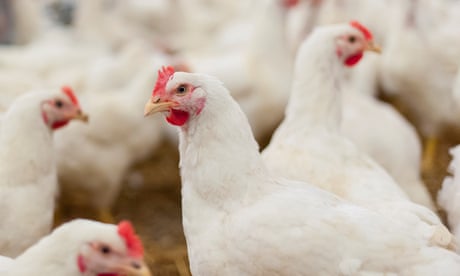Artificial intelligence that could improve the welfare of farmed chickens by eavesdropping on their squawks could become available within five years, researchers say. The technology, which detects and quantifies distress calls made by chickens housed in huge indoor sheds, correctly distinguished distress calls from other barn noises with 97% accuracy, new research suggests. A similar approach could eventually be used to drive up welfare standards in other farmed animals.
Each year, about 25 billion chickens are farmed around the world – many of them in huge sheds, each housing thousands of birds. One way to assess the welfare of such creatures is to listen to the sounds that they make. “Chickens are very vocal, but the distress call tends to be louder than the others, and is what we would describe as a pure tonal call,” said Alan McElligott, an associate professor of animal behaviour and welfare at the City University of Hong Kong.
“Even to the untrained ear, it’s not too difficult to pick them out. ” In theory, farmers could use chickens’ calls to gauge their level of distress, and enrich their housing where necessary. However, in commercial flocks containing thousands, or tens of thousands of chickens, deploying human observers is impractical.
For one thing, their presence could further stress the flock, but with so many birds, objectively quantifying the number of distress calls is impossible, McElligott said. Instead, his team has developed a deep learning tool to automatically identify chicken distress calls from recordings of intensively farmed chickens. The tool was trained using recordings that had already been manually classified by human experts, to determine which type of sound they represented.
00:17 Researchers detect chickens’ ‘distress cluck’ – audio According to an evaluation published in the Journal of the Royal Society Interface , the algorithm correctly identified 97% of distress calls. “Our end goal is not to count distress calls, but to create conditions in which the chickens can live and have a reduced amount of distress,” said McElligott, who estimates that the technology could be commercially deployed within five years. Before that happens, the team will need to ensure that the recording equipment works in different types of chicken shed, as well as testing it in farms with higher or lower welfare standards to confirm the readings correlate.
Persuading farmers to adopt the technology may be relatively easy. Previous research by McElligott found that distress calls made by young chicks could predict the amount of weight gained and the number of deaths in the whole flock during its lifetime. “Sometimes it’s difficult to convince the farmers that have to deal with producing these animals for a set price for supermarkets and everyone else to adopt technology to improve their welfare,” McElligott said.
“But we’ve already shown that distress calls are a good indicator of mortality and growth rates, and this is a way of automating the process. ” Similar technology could be developed to monitor other farmed animals – particularly pigs or turkeys, which are also frequently housed indoors and are highly vocal, he added. The RSPCA broadly welcomed the research.
“Technology such as this can be incredibly useful in monitoring and improving the welfare of farm animals, but we wouldn’t want to see this replace physical inspections or reduce stock keeper-bird contact, as this could lead to a loss of stockmanship skills, or birds that are more difficult to handle,” a spokesperson said. “Also, the vocalisation of distress is just one welfare indicator, but there are a number of other physical factors such as lameness and leg burns which farmers should also be looking out for. ”.
From: theguardian
URL: https://www.theguardian.com/science/2022/jun/29/ai-could-improve-welfare-of-farmed-chickens-by-listening-to-their-squawks



